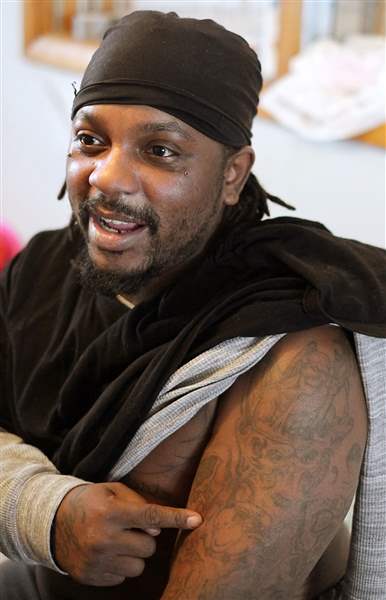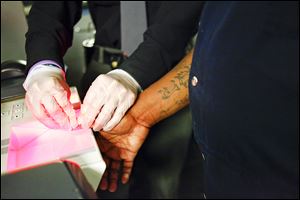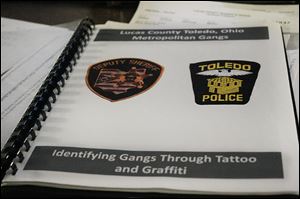
GANGS OF TOLEDO
Tattoos honor gangs, the fallen, and the hustle
Inked tributes also help police identify local crime suspects
12/29/2013
Lorenzo Leake of Toledo, also known as Lucky, is a tattoo artist who does gang tattoos. He paid for his first tattoo at age 14.
THE BLADE/JEREMY WADSWORTH
Buy This Image

A man brought in by the Toledo police Gangs Unit has his fingerprints scanned by a corrections officer in the booking area of the Lucas County jail. Tattoos are sometimes photographed.
At 14 years old, his allegiance to the gang became permanent.
Using the money he made selling drugs, he paid an addict to ink a horned bulldog wearing a red collar on his left bicep.
“It’s to represent your neighborhood,” said Larenzo Leake, 33, who joined the Unknown Villains, Bloods, before he was even a teenager. “That's the way I looked at it — rep my hood.”
The black and red ink is fading, and to someone making a passing glance at the hundreds of tattoos that now cover Leake’s upper body, they might not give them a second thought.
“I would think that members that get tattoos … are more committed members,” said Adam Watkins, an associate professor of criminal justice at Bowling Green State University who has studied, and teaches about, gangs.
The tattoos honor the gang, the fallen, the hustle.
They are promises. Promises to stay loyal, to stay quiet, to honor the streets, to never forget.
Sometimes it’s a promise to die for those who ride with you.
On Leake’s left arm: N.O.N.
North or nothing.
On March 22, 2001, a young boy was shot in the back. The Crips blamed the Unknown Villains, and the next night, they decided to show their bravado.
“I knew what was going to go down,” Leake said. “That was our intention, to go up there and get it on. Let’s get it on and over with. See how many people come out dead.”
Leake and his friends went to Mr. J's, a now shuttered bar at North Detroit and West Woodruff avenues that was well out of their territory.
A fight broke out inside the bar and spilled onto the street.
The shooting started. Leake said he shot two people.
He was eventually convicted of felonious assault and sentenced to serve an eight-year prison sentence.
During his incarceration, using a prison-made gun, he learned how to tattoo. It became his hustle.
Out of prison since 2009, Leake, who is known to his friends as “Lucky,” does tattoos in his West Toledo home. Most of the tattoos represent some facet of gang life.
“I done seen it all,” Leake said. “You doing gang activity, a person going to put it on their body.”

Lorenzo Leake of Toledo, also known as Lucky, is a tattoo artist who does gang tattoos. He paid for his first tattoo at age 14.
Obvious or subtle
Gang tattoos come in all shapes and sizes. Some are obvious.
Tremayne Griffin, a member of the Manor Boyz, a Blood set that hangs around the Moody Manor apartment complex in central Toledo, has a brick wall with “Moody Manor” inked over it on one arm.
That makes plausible deniability more difficult.
Other times, loyalty is more subtle. A flower with six petals might mean you run with a Crip or Folks set; a crown with five points could mean Bloods.
Someone who claims Stickney 33 might tattoo “tres tres” somewhere. A member of the Beehive — those who aren't in federal prison after a sting in 2011 — might, somewhat predictably, have a bee.

The Lucas County jail gang identifying folder is used by officials to distinguish gang markings.
Aiding police
While the tattoos are another means to represent a block or neighborhood, they help law enforcement identify suspects.
That methodology was used to solve the city’s first homicide this year.
Surveillance video from South Beach Bar and Grill showed that a man with “CHOLO” tattooed on his head was near Christina Henderson just moments before she was fatally stabbed just after 2 a.m. on New Year’s Day.
Hector Alvarado, Jr., 40, is now in prison, serving 15 years to life for her death.
At the jail
Tattoos are occasionally photographed by corrections officers at the Lucas County jail, but some officers don’t know the difference between innocuous ink and one with more significance.
It was very early on Nov. 15 when a young man was brought into the Lucas County jail on an assault charge.
Veteran Corrections Officer Amin Watkins asked the man to lift up the left sleeve of his white T-shirt to reveal a tattoo on his arm: “Real Bloodz Don’t Die.”
“There is zero training on gang tattoos, and there should be,” said Corrections Officer Damian Worthy.
Photographing tattoos as inmates are booked into the jail is critical, Officer Worthy said. For an officer on the streets looking for a suspect, “sometimes it’s the only thing that sets them apart.”
Some officers, such as Officer Worthy, know what to look for. The know-how usually doesn’t come from work experience, but rather an officer’s background.
Officer Worthy, 39, grew up in North Toledo around people who ran with gangs — who sometimes visit him in jail, albeit not by choice.
Earlier this year, after a fight broke out in the jail between two rival gang members, corrections officers asked the Toledo Police Department for information that would help identify gangs.
Months later, they got a 23-page book with pictures of various gang tattoos and graffiti that represent 26 different gangs in Toledo.
Many of the tattoos are simple, like numbers to distinguish which block someone is from: 900 (900 Boys), 3200 (Glenwood Avenue XBlocc), 800 (Cherry Woodz), 2400 (Lawrence Blood Villains), 1100 (Woodstocc), 2900 (Manor Boyz), to name a few.
One man recently arrested on a murder charge has various XBlocc tattoos, including a piece across his entire chest that depicts a brick wall and three round-top doors. On each door is the street name of a gang member who is behind bars.

The fallen
Tattoos to represent friends are common, though they’re usually a memorial for someone who has died, oftentimes as a result of violence.
“Majority of us gone,” Leake said of the Unknown Villains. “I got stuff everywhere, like for my dead homies.”
Leake points to the top of one hand where he has a tattoo for his cousin, Derrick Turner, a Crip who was shot dead in April, 1998.
Turner later became the namesake for XBlocc, a Crip-affiliated gang that claims territory north of Central Avenue on the outskirts of the Old West End.
There’s another tattoo for William Pope, who was 21 years old when, on Oct. 23, 1999, his body was found in the trunk of a Cadillac in Perrysburg.
‘It’s about money’
Leake said he does tattoos for anyone who wants one — Bloods, Crips, Folks.
Now that he’s older, has some rank, and isn’t banging on the block, he has respect from all parts of town.
On Thursday afternoon, a man who claims the Cherry Woodz, a Crips gang, called to ask about getting a tattoo later that day.
“It’s about money,” Leake said. “That’s my work. That's what I do. Crip, Folk, Blood, Vice Lord. Doesn’t make a difference.”
He does caution customers on occasion — “Are you sure you want this on you?” he asks. “It’s going to be on you for the rest of your life.”
A permanent allegiance.
Contact Taylor Dungjen at tdungjen@theblade.com, or 419-724-6054, or on Twitter @taylordungjen.